高考英语特殊句式 课件(52张PPT)
图片预览


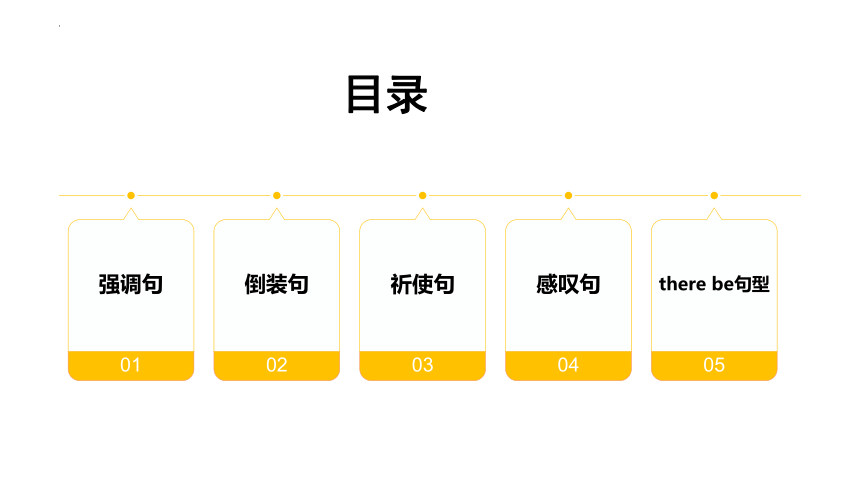
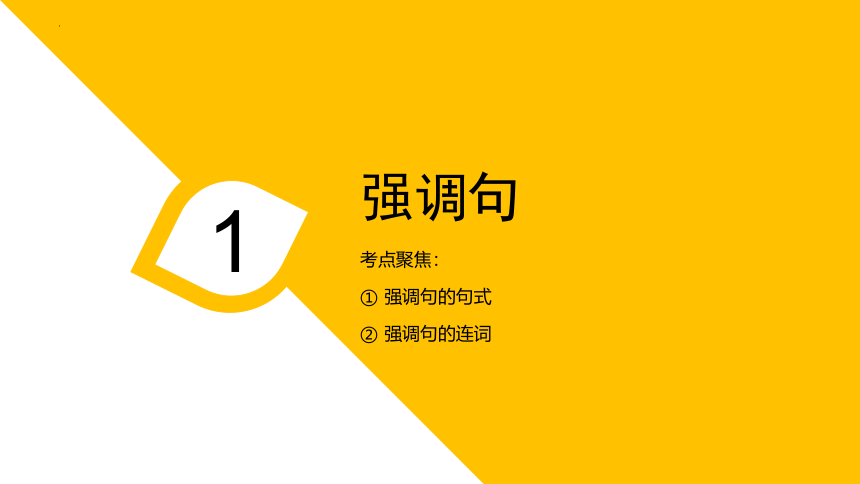
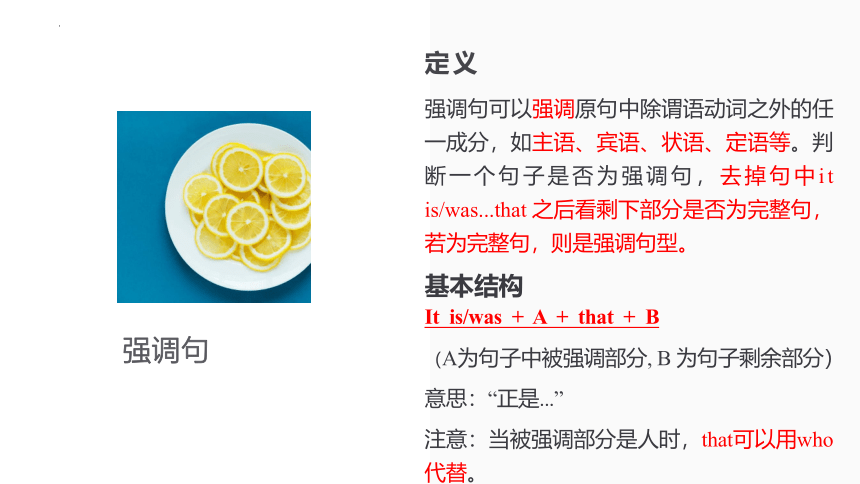
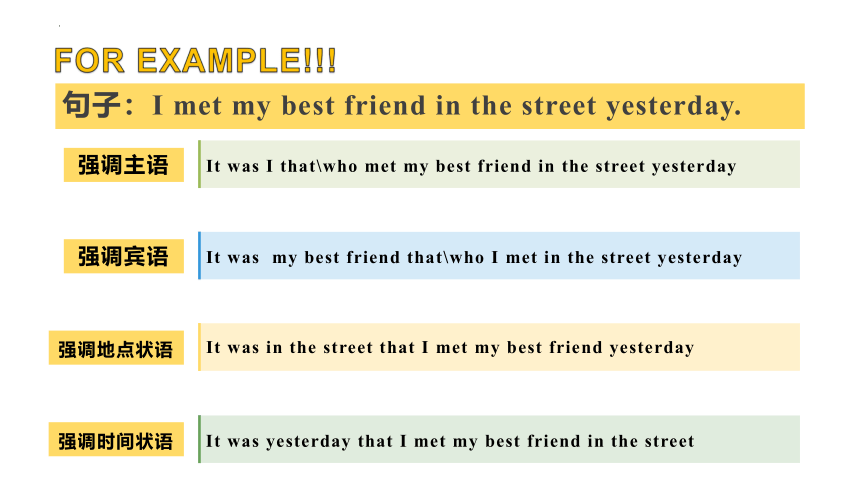
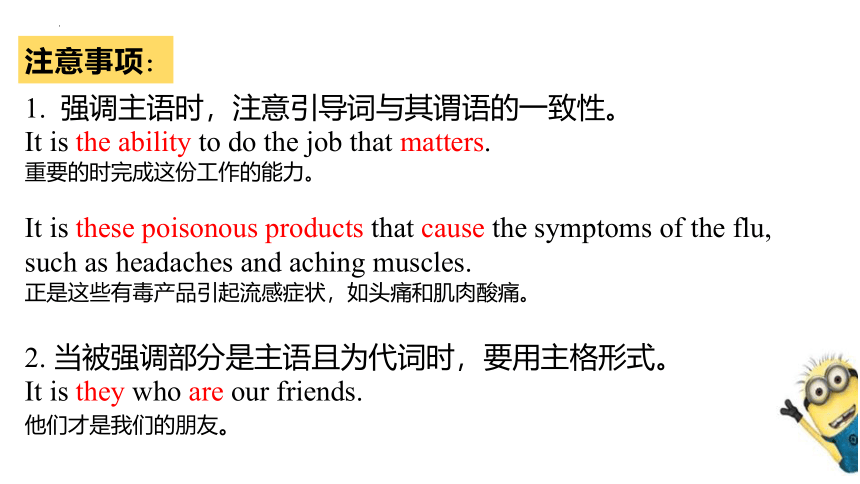
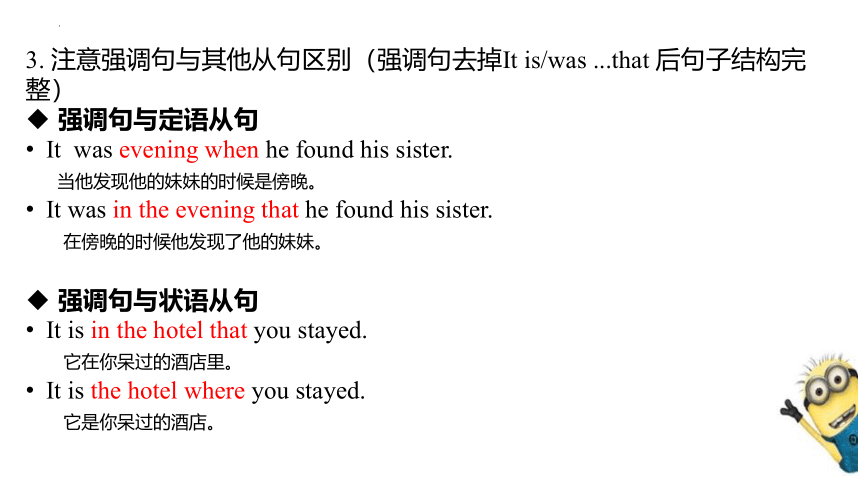
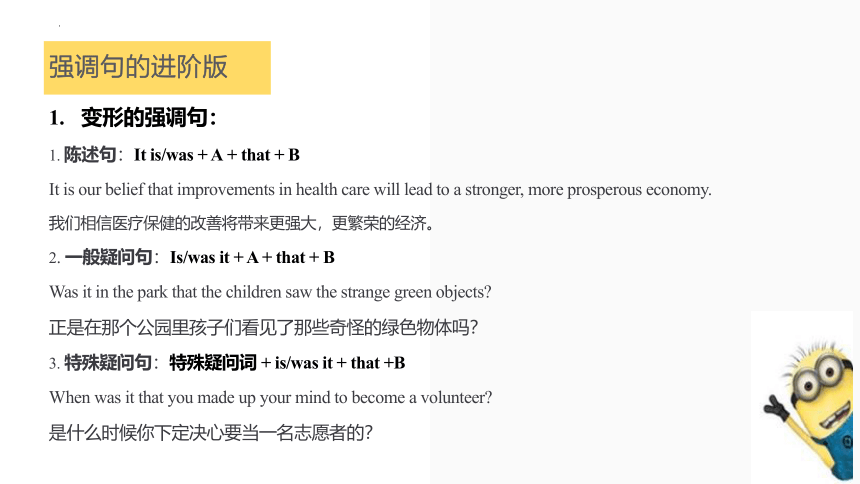
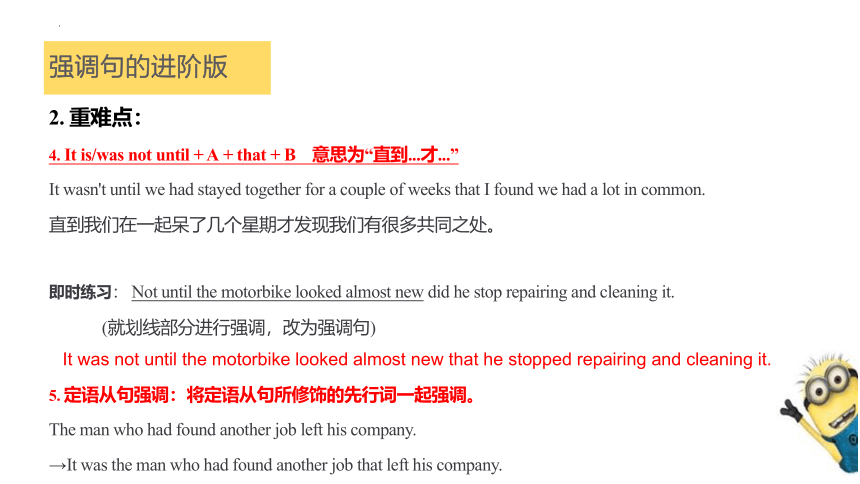
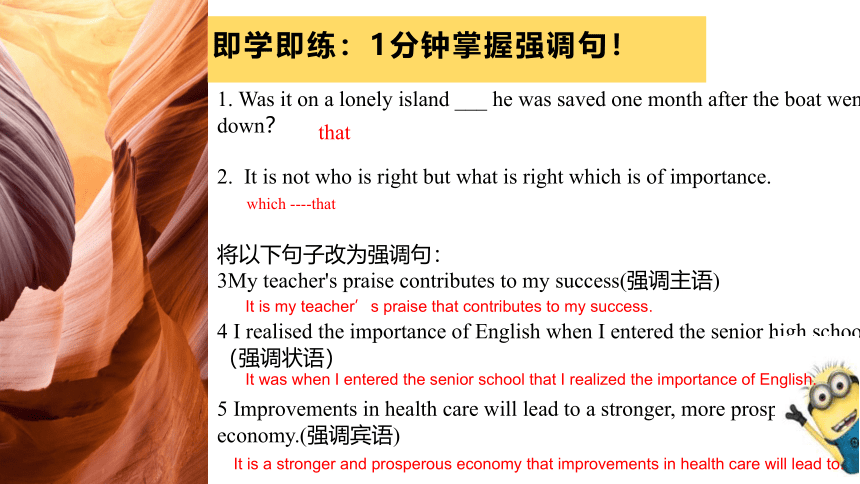
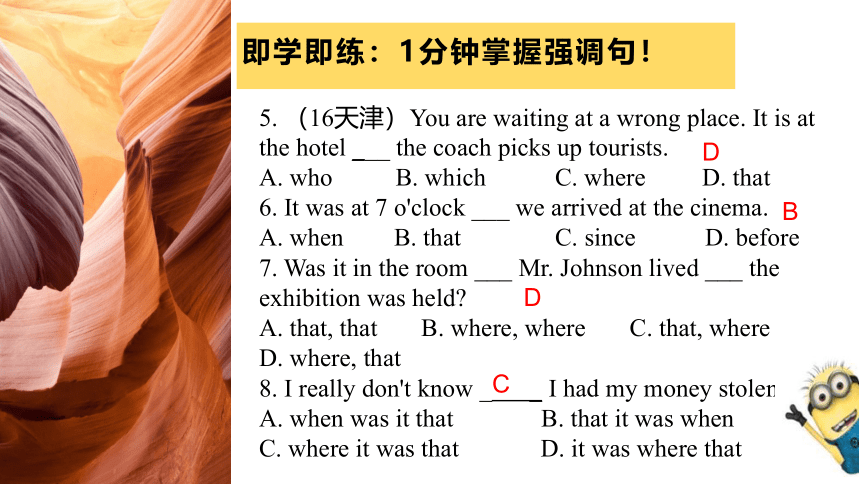
文档简介
(共52张PPT)
特殊句式
倒装句、感叹句、祈使句、强调句等
高考聚焦
试题分析
2014课标Ⅱ短文改错考查了 there be句型
2016课标Ⅱ语法填空考察了祈使句的用法
2017年短文改错考查了祈使句的用法
趋势分析
高考教学的重点内容:倒装句、祈使句、there be句型等
加分亮点:高考写作中恰当使用倒装句、强调句或者祈使句会给阅卷者留下良好的印象
目录
01
强调句
05
there be句型
02
倒装句
03
祈使句
04
感叹句
强调句
考点聚焦:
强调句的句式
强调句的连词
1
强调句可以强调原句中除谓语动词之外的任一成分,如主语、宾语、状语、定语等。判断一个句子是否为强调句,去掉句中it is/was...that 之后看剩下部分是否为完整句,若为完整句,则是强调句型。
定义
It is/was + A + that + B
(A为句子中被强调部分, B 为句子剩余部分)
意思:“正是...”
注意:当被强调部分是人时,that可以用who代替。
基本结构
强调句
FOR EXAMPLE!!!
强调时间状语
It was yesterday that I met my best friend in the street
强调地点状语
It was in the street that I met my best friend yesterday
强调宾语
It was my best friend that\who I met in the street yesterday
强调主语
It was I that\who met my best friend in the street yesterday
句子:I met my best friend in the street yesterday.
1. 强调主语时,注意引导词与其谓语的一致性。
It is the ability to do the job that matters.
重要的时完成这份工作的能力。
It is these poisonous products that cause the symptoms of the flu, such as headaches and aching muscles.
正是这些有毒产品引起流感症状,如头痛和肌肉酸痛。
2. 当被强调部分是主语且为代词时,要用主格形式。
It is they who are our friends.
他们才是我们的朋友。
注意事项:
3. 注意强调句与其他从句区别(强调句去掉It is/was ...that 后句子结构完整)
强调句与定语从句
It was evening when he found his sister.
当他发现他的妹妹的时候是傍晚。
It was in the evening that he found his sister.
在傍晚的时候他发现了他的妹妹。
强调句与状语从句
It is in the hotel that you stayed.
它在你呆过的酒店里。
It is the hotel where you stayed.
它是你呆过的酒店。
变形的强调句:
1. 陈述句:It is/was + A + that + B
It is our belief that improvements in health care will lead to a stronger, more prosperous economy.
我们相信医疗保健的改善将带来更强大,更繁荣的经济。
2. 一般疑问句:Is/was it + A + that + B
Was it in the park that the children saw the strange green objects
正是在那个公园里孩子们看见了那些奇怪的绿色物体吗?
3. 特殊疑问句:特殊疑问词 + is/was it + that +B
When was it that you made up your mind to become a volunteer
是什么时候你下定决心要当一名志愿者的?
强调句的进阶版
2. 重难点:
4. It is/was not until + A + that + B 意思为“直到...才...”
It wasn't until we had stayed together for a couple of weeks that I found we had a lot in common.
直到我们在一起呆了几个星期才发现我们有很多共同之处。
即时练习: Not until the motorbike looked almost new did he stop repairing and cleaning it.
(就划线部分进行强调,改为强调句)
5. 定语从句强调:将定语从句所修饰的先行词一起强调。
The man who had found another job left his company.
→It was the man who had found another job that left his company.
强调句的进阶版
It was not until the motorbike looked almost new that he stopped repairing and cleaning it.
即学即练:1分钟掌握强调句!
1. Was it on a lonely island ___ he was saved one month after the boat went down?
2. It is not who is right but what is right which is of importance.
将以下句子改为强调句:
3My teacher's praise contributes to my success(强调主语)
4 I realised the importance of English when I entered the senior high school.(强调状语)
5 Improvements in health care will lead to a stronger, more prosperous economy.(强调宾语)
It is my teacher’s praise that contributes to my success.
It was when I entered the senior school that I realized the importance of English.
It is a stronger and prosperous economy that improvements in health care will lead to.
that
which ----that
即学即练:1分钟掌握强调句!
5. (16天津)You are waiting at a wrong place. It is at the hotel ___ the coach picks up tourists.
A. who B. which C. where D. that
6. It was at 7 o'clock ___ we arrived at the cinema.
A. when B. that C. since D. before
7. Was it in the room ___ Mr. Johnson lived ___ the exhibition was held
A. that, that B. where, where C. that, where
D. where, that
8. I really don't know _ _ I had my money stolen. C
A. when was it that B. that it was when
C. where it was that D. it was where that
D
B
D
C
倒装句
考点聚焦:
倒装句的类型
倒装句的句式
部分倒装的助动词应用
2
倒装句为了强调、突出等词语的目的而颠倒原有语序的句式叫做倒装句。在倒装句中,颠倒了的成分可以恢复原位而句意基本不变,句法成分不变。
定义
完全倒装
部分倒装
基本类型
倒装句
*句子基本语序
主语+谓语+宾语
I like English.
完全倒装
部分倒装
*倒装的类型
谓语+主语
系动词/情态动词/助动词+ 主语
一、
二、
引入
一、完全倒装
Here comes the bus.
1.
表地点、时间、方位的副词置于句首:
(there, here , then,now,in, out, up, down, away, off, 等
谓语动词常用come,go, be, lie,run,等)
注意:
主语为人称代词时,不倒装。
看,他来了 : Here_________
he comes.
完全倒装是将整个谓语移到主语前面
完全倒装
表示地点状语的介词短语位于于句首:
(谓语通常是be , stand, sit , lie 等动词)
At the foot of the hill lies a beautiful lake.
Inside the box is a cat.
2.
注意:
主谓保持一致,(stand)
Under the tree_______ a boy.
Under the tree_______ two boys.
stands
stand
完全倒装
作表语的形容词, 过去分词,现在分词置于句首:
Present at the meeting was Professor White.
Gone are the days when we were children.
Standing beside the table was an writer.
*强调:Such, The following等放句首时,句子要完全倒装。
2)The following is the answer to the question.
1)Such is life.
3.
练习:
1) There ________. And here ________.
A. goes the phone; she comes
B. is the phone going; is she
C. does the phone go; does she come
D. the phone goes; come she
A
2) ________, a man of achievements, deep thoughts, but with simple habits.
A. Einstein was such B. Such was Einstein
C. Einstein was so D. So was Einstein
B
练习:
3) Out ________, with a stick in his hand.
A. did he rush B. rushed he
C. he rushed D. he did rush
4) ________ from the top of the building when the policeman pointed the gun at him.
A. Jumped down the robber
B. Jumped the robber down
C. Down jumped the robber
D. Down the robber jumped
c
c
二、部分倒装
部分倒装是把be动词、情态动词、助动词放到主语之前。
be动词
情态动词 + 主语
助动词do/does/did
表示否定的副词、介词短语或连词位于句首:
高考常考的这类词或词语有: seldom, never, rarely, little, not a bit, no longer/more, nowhere, in no way ,at no time,by no means,on no condition等
Hardly did he know that the police were after him.
Never have I seen him before.
Little did I realize it.
In no way will I go there.
二、部分倒装
1.
(1)一……就……句型
No sooner … than …
Hardly … when …
Scarcely … when …
(位于句首)
她一离开电话就响了。
No sooner ____ _____ the house than the telephone rang.(she leave)
过去完成时
(had sb done)
一般过去时
(did)
(部分倒装) (不倒装)
常考词组应用:
had she left
常考词组应用:
Not until the teacher came / yesterday
did he finish his homework.
注意: (强调句,不倒装)
It was not until the teacher came that he finished his homework.
Not until放在句首,从句不倒装, 后面
主句部分倒装。
Not until + 从句/时间词 +主句部分倒装
(2)
注意:not only...but also...连接主语时,不倒装。如:
Not only the mother but also the children _____ sick.
(were/was)
_____ wrong, but aslo his friends were wrong.
A. Not was only he B. Not only he
C. Not only was he D. Not only was
c
“Not only + 分句,but also + 分句”句型
Not only位于句首,前一分句要部分倒装
Not only did he work faster, but also he worked
better.
常考词组应用:
were
(3)
(4)Neither ...nor ...,
连接两个并列分句时,这两个分句都要用部分倒装.
Neither __________it , nor _______________it .
(I know) (I care about)
do I know
do I care about
常考词组应用:
部分倒装
2. So, neither/nor 开头表示另一事物
“也”或”也不”的句子:
-- Tom can answer the question.
-- So __________(我也会)
--Do you know he is a famous writer
--I don’t know, and nor ________ about it.
(我不知道,我也不在乎)
can I
do I care
试比较:
I like sports.
So does he. (部分倒装)
他也是
- He likes sport。
- So he does. (不倒装)
表示同一事物“确实如此”,So 后接陈述句语序,不倒装。
他确实如此
1.
2.
__________________
_________________
部分倒装基本规则
·So loudly ___________ that even people in the next
room could hear him.
3. 如此…以至于…结构中
So … that…, So + adj./adv. 置于句首时
Such … that … , Such + n.置于句首时,
主句部分倒装,that从句不倒装
如:he spoke so loudly that even people in the next room
could hear him.
did he speak
4. As引导让步状语从句,必须将表语,状语或从句动词提前
部分倒装
Pretty as she is, she is not clever.
Though he was a child, he had to make a living.
=
______________, he had to make a living.
注意:
表语为单数可数名词,提前名词不用冠词
Hard as he worked, he failed.
Child as he was
部分倒装
5. If 引导的虚拟条件句中,
可以省略if,提前 should, had, were
If I were you, I would never give up.
_________, I would accept the invitation.
Were I you
部分倒装
6. Only+状语(副词,介词短语,状语从句)在句首:
1)Only then did I realize the importance of math.
2)Only by working hard can we succeed。
3)Only when the war was over in 1918 was he able
to get happily back to work.
7. 用于某些表示祝愿或口号的句子:
May you succeed!
完全倒装是将整个谓语移到主语前面。
完全倒装
表地点、时间、方位的副词置于句首
(there, here , then,now,in, out, up, down, away, off, 等
谓语动词常用come,go, be, lie,run,等)
2.表示地点状语的介词短语位于于句首
(谓语通常是be , stand, sit , lie 等动词)
3.作表语的形容词, 过去分词,现在分词置于句首
部分倒装是把be动词、情态动词、助动词放到主语之前。
1.表示否定的副词、介词短语或连词位于句首:
2. So, neither/nor 开头表示另一事物 “也”或”也不”的句子:
3. 如此…以至于…结构中
So … that…, So + adj./adv. 置于句首时
Such … that … , Such + n.置于句首时,
主句部分倒装,that从句不倒装
4. As引导让步状语从句,必须将表语,状语或从句动词提前 。
5. If 引导的虚拟条件句中, 可以省略if,提前 should, had, were
6. Only+状语(副词,介词短语,状语从句)在句首:
7. 用于某些表示祝愿或口号的句子:
部分倒装
1. Hardly_______ when it began to rain.
A. had he arrived B. arrived he
C. he had arrived D. did he arrive
2. Under a big tree ____, half asleep.
A. did sat a fat man B. a fat man sat
C. did a fat man sat D. sat a fat man
D
A
倒装句练习
3. ______, the boy knows a lot about computer.
A. Though is he young B. As is he young
C. Young as is he D. Young as he is
.
D
4. Not only ____a promise, but also he kept it. A. has he made B. does he make C. he made D. did he make
D
5. Not until he got off the bus _____that he had got his wallet stolen.
A. he found B. did he find C. he had found D. had he found
B
6. She plays the piano very well._________. A. So every one of us does B. Every one of us does C. So does every one of us D. So do every one of us
C
写作中的倒装句
变换句型
I will never give up .
I can learn English well only in this way.
The time is so precious that we can not afford to waste it.
Never will I give up.
Only in this way can I learn English well.
So precious is the time that we can not afford to waste it.
应用倒装语法翻译句子
只有努力工作,你才能取得成功。
在两座教学楼中间有一棵大树。
通过阅读名著,我们不仅能开阔眼界丰富知识,而且还能提高写作能力。
Only by working hard can you succeed.
Between the two teaching buildings stands a tall tree.
Not only can we broaden our horizons and enrich our knowledge but also we will be able to improve writing skills by reading famous works.
祈使句
考点聚焦:
祈使句的句型
倒装句的两个重要应用
3
用于表达命令、请求、劝告、警告、禁止等的句子叫做祈使句。祈使句一般以动词原形开头,没有时态和数的变化
定义
(1)第二人称祈使句 Stand up please!
(2)第一、三人称祈使句 Let us clean the room!
(3)名词、副词、动词短语 类没有谓语的祈使句
Help! Patience! Quickly!
基本类型
祈使句
句型及表现形式:
一、祈使句
1、Do型(即:动词原形(+宾语)+其它成分)
eg. Please have a seat here.
肯定结构
2、Be型(即:Be + 表语(名词或形容词)+其它成分)
eg. Be a good boy!
3、Let型(即:Let + 宾语 + 动词原形 + 其它成分)
eg. Let us clean the room.
1、Do型和Be型的否定式都是在句首加don't构成eg. Don't be late.
否定结构
2、Let型的否定式有两种:
“Don't + let + 宾语 + 动词原形 + 其它成分”
“Let + 宾语 + not + 动词原形 + 其它成分"。
eg. Let him be here by 10 o’clock.
eg. Let him not waste time .
3、有些直接开头加no
eg. No smoking.
1、祈使句用于两个重要句型中
(1) “祈使句+and+表结果的陈述句”用来叙述肯定的条件.
(2) “祈使句+or(else)+表结果的陈述句”用来叙述否定的条件,or(else)表示“否则;要不然”.
Hurry up and you’ll catch the train.(=If you hurry up,you’ll catch the train.)
Hurry up,or you’ll miss the train.(=If you don’t hurry up,you’ll miss the train.
2、祈使句由直接引语变成间接引语
当祈使句由直接引语变成间接引语时,其常用结构为“ask/request/tell/order sb(not)to do sth”.如:
“Speak loudly,please!” the teacher said to me.
(=The teacher asked me to speak loudly.)
“Don’t smoke in the meeting room!” he said to Tom.
(=He told Tom not to smoke in the meeting room.
二、祈使句的应用
三、练习题
1.Find ways to praise your children often, you'll find they will open their hearts to you.(2012山东高考)
A.till B.Or C.and D.but
2. at the door before you entering my room,please.[2012北京]
A.Knock B.Knocking C.Knocked D.To Knick
3. what you’re doing today important,because you’re trading a day of your life for it.(2014湖南)
A.Make B.To make C.Making D.Made
4. me tomorrow and I will let you know the lab result.(2014全国I)
A.calling B.Call C.To call D.Having called
5. Give me a chance, I’ll give you a wonderful surprise.(2014天津)
A.if B.or C.and D.while
6.Our English teacher is ill.Let's go and see him after school, ?
A.doesn't he B.don't we C.shall we D.will you
参考答案:CAABC CADCD
感叹句
考点聚焦:
感叹句的句型
what 和how的区别
4
感叹句(Exclamatory sentences)是用来表达较强烈情感时所使用的句子类型。
定义
what和how引导的感叹句
分类
倒装句
--Whata happy day it is!多么快乐的一天啊!Whatbeautiful butterflies they are!多么漂亮的蝴蝶啊!Howtall a boy he is!这个男孩真高啊!Howwell she plays!她演奏得多好啊!感叹句的句型总结:
1.what与how引导的感叹句的区别:
how修饰形容词、副词或动词
what修饰名词
2.由how与what引导的感叹句句型一中(单数名词),在一般情况下可以相互转换,转换后意义不变。
What an interesting story it is!
= How interesting the story is!
感叹句的练习题
1. fast he runs!
2. nice the boy is!
3. a wonderful time we had yesterday !
4. fine weather it is !
5.The little boy came riding at full speed down motorway on his bicycle. a dangerous scene it was.
6. noise they are making!
7. ___ food you've cooked!
A. How a nice B. What a nice C. How nice D. What nice
8.___terrible weather we've been having these days!
A. What B. What a C. How D. How a
参考答案:1How 2 How 3 What 4 What
5 What 6 How 7-9 DA
There be句型
考点聚焦:
there be 的句型
there be 句型的就近原则
5
There be 句型是英语中常用句型, 意思是“有”,表示“人或事物的存在”或“某地有某物”。There在此结构中是引导词,已经没有副词“那里”的含义。。
定义
There be 的就近原则
There be 用于写作
考点
There be句型
There be 句型的用法
1. 基本句型: “There be + 名词+ 地点(时间)
2. 变形:There be 中的be 有时可以是lie,stand,used to be,seem to be,appear to be 等,
There lies a river to the south.
There stood a temple near the river.
3. 语法: 1.there be 句型的主语为后面的名词
2. there be 句型符合就近原则 :There be 后面是几个并列名词做主语时,
动词be的形式和最靠近它的那个名词保持数的一致。
There is an ashtray and two bottles on the shelf.
There are two bottles and an ashtray on the shelf.
练习题
参考答案:1 is 2 is 3 There are 4 Is there
5 are ; classes 6 is ; no
练习题
一、根据所给汉语完成句子,
1.桌子上有一本书和两支钢笔。 There a book and two pens on the desk.
2.钱包里有些钱。 There some money in the picture
3.在吉姆的书包里有一些卡片。 some cards in Jims bag.
4.里面还有其他的东西吗 anything else in?
5.我们学校有许多班, There many our school.
5.树上没有鸟。There birds in the tree.
特殊句式
倒装句、感叹句、祈使句、强调句等
高考聚焦
试题分析
2014课标Ⅱ短文改错考查了 there be句型
2016课标Ⅱ语法填空考察了祈使句的用法
2017年短文改错考查了祈使句的用法
趋势分析
高考教学的重点内容:倒装句、祈使句、there be句型等
加分亮点:高考写作中恰当使用倒装句、强调句或者祈使句会给阅卷者留下良好的印象
目录
01
强调句
05
there be句型
02
倒装句
03
祈使句
04
感叹句
强调句
考点聚焦:
强调句的句式
强调句的连词
1
强调句可以强调原句中除谓语动词之外的任一成分,如主语、宾语、状语、定语等。判断一个句子是否为强调句,去掉句中it is/was...that 之后看剩下部分是否为完整句,若为完整句,则是强调句型。
定义
It is/was + A + that + B
(A为句子中被强调部分, B 为句子剩余部分)
意思:“正是...”
注意:当被强调部分是人时,that可以用who代替。
基本结构
强调句
FOR EXAMPLE!!!
强调时间状语
It was yesterday that I met my best friend in the street
强调地点状语
It was in the street that I met my best friend yesterday
强调宾语
It was my best friend that\who I met in the street yesterday
强调主语
It was I that\who met my best friend in the street yesterday
句子:I met my best friend in the street yesterday.
1. 强调主语时,注意引导词与其谓语的一致性。
It is the ability to do the job that matters.
重要的时完成这份工作的能力。
It is these poisonous products that cause the symptoms of the flu, such as headaches and aching muscles.
正是这些有毒产品引起流感症状,如头痛和肌肉酸痛。
2. 当被强调部分是主语且为代词时,要用主格形式。
It is they who are our friends.
他们才是我们的朋友。
注意事项:
3. 注意强调句与其他从句区别(强调句去掉It is/was ...that 后句子结构完整)
强调句与定语从句
It was evening when he found his sister.
当他发现他的妹妹的时候是傍晚。
It was in the evening that he found his sister.
在傍晚的时候他发现了他的妹妹。
强调句与状语从句
It is in the hotel that you stayed.
它在你呆过的酒店里。
It is the hotel where you stayed.
它是你呆过的酒店。
变形的强调句:
1. 陈述句:It is/was + A + that + B
It is our belief that improvements in health care will lead to a stronger, more prosperous economy.
我们相信医疗保健的改善将带来更强大,更繁荣的经济。
2. 一般疑问句:Is/was it + A + that + B
Was it in the park that the children saw the strange green objects
正是在那个公园里孩子们看见了那些奇怪的绿色物体吗?
3. 特殊疑问句:特殊疑问词 + is/was it + that +B
When was it that you made up your mind to become a volunteer
是什么时候你下定决心要当一名志愿者的?
强调句的进阶版
2. 重难点:
4. It is/was not until + A + that + B 意思为“直到...才...”
It wasn't until we had stayed together for a couple of weeks that I found we had a lot in common.
直到我们在一起呆了几个星期才发现我们有很多共同之处。
即时练习: Not until the motorbike looked almost new did he stop repairing and cleaning it.
(就划线部分进行强调,改为强调句)
5. 定语从句强调:将定语从句所修饰的先行词一起强调。
The man who had found another job left his company.
→It was the man who had found another job that left his company.
强调句的进阶版
It was not until the motorbike looked almost new that he stopped repairing and cleaning it.
即学即练:1分钟掌握强调句!
1. Was it on a lonely island ___ he was saved one month after the boat went down?
2. It is not who is right but what is right which is of importance.
将以下句子改为强调句:
3My teacher's praise contributes to my success(强调主语)
4 I realised the importance of English when I entered the senior high school.(强调状语)
5 Improvements in health care will lead to a stronger, more prosperous economy.(强调宾语)
It is my teacher’s praise that contributes to my success.
It was when I entered the senior school that I realized the importance of English.
It is a stronger and prosperous economy that improvements in health care will lead to.
that
which ----that
即学即练:1分钟掌握强调句!
5. (16天津)You are waiting at a wrong place. It is at the hotel ___ the coach picks up tourists.
A. who B. which C. where D. that
6. It was at 7 o'clock ___ we arrived at the cinema.
A. when B. that C. since D. before
7. Was it in the room ___ Mr. Johnson lived ___ the exhibition was held
A. that, that B. where, where C. that, where
D. where, that
8. I really don't know _ _ I had my money stolen. C
A. when was it that B. that it was when
C. where it was that D. it was where that
D
B
D
C
倒装句
考点聚焦:
倒装句的类型
倒装句的句式
部分倒装的助动词应用
2
倒装句为了强调、突出等词语的目的而颠倒原有语序的句式叫做倒装句。在倒装句中,颠倒了的成分可以恢复原位而句意基本不变,句法成分不变。
定义
完全倒装
部分倒装
基本类型
倒装句
*句子基本语序
主语+谓语+宾语
I like English.
完全倒装
部分倒装
*倒装的类型
谓语+主语
系动词/情态动词/助动词+ 主语
一、
二、
引入
一、完全倒装
Here comes the bus.
1.
表地点、时间、方位的副词置于句首:
(there, here , then,now,in, out, up, down, away, off, 等
谓语动词常用come,go, be, lie,run,等)
注意:
主语为人称代词时,不倒装。
看,他来了 : Here_________
he comes.
完全倒装是将整个谓语移到主语前面
完全倒装
表示地点状语的介词短语位于于句首:
(谓语通常是be , stand, sit , lie 等动词)
At the foot of the hill lies a beautiful lake.
Inside the box is a cat.
2.
注意:
主谓保持一致,(stand)
Under the tree_______ a boy.
Under the tree_______ two boys.
stands
stand
完全倒装
作表语的形容词, 过去分词,现在分词置于句首:
Present at the meeting was Professor White.
Gone are the days when we were children.
Standing beside the table was an writer.
*强调:Such, The following等放句首时,句子要完全倒装。
2)The following is the answer to the question.
1)Such is life.
3.
练习:
1) There ________. And here ________.
A. goes the phone; she comes
B. is the phone going; is she
C. does the phone go; does she come
D. the phone goes; come she
A
2) ________, a man of achievements, deep thoughts, but with simple habits.
A. Einstein was such B. Such was Einstein
C. Einstein was so D. So was Einstein
B
练习:
3) Out ________, with a stick in his hand.
A. did he rush B. rushed he
C. he rushed D. he did rush
4) ________ from the top of the building when the policeman pointed the gun at him.
A. Jumped down the robber
B. Jumped the robber down
C. Down jumped the robber
D. Down the robber jumped
c
c
二、部分倒装
部分倒装是把be动词、情态动词、助动词放到主语之前。
be动词
情态动词 + 主语
助动词do/does/did
表示否定的副词、介词短语或连词位于句首:
高考常考的这类词或词语有: seldom, never, rarely, little, not a bit, no longer/more, nowhere, in no way ,at no time,by no means,on no condition等
Hardly did he know that the police were after him.
Never have I seen him before.
Little did I realize it.
In no way will I go there.
二、部分倒装
1.
(1)一……就……句型
No sooner … than …
Hardly … when …
Scarcely … when …
(位于句首)
她一离开电话就响了。
No sooner ____ _____ the house than the telephone rang.(she leave)
过去完成时
(had sb done)
一般过去时
(did)
(部分倒装) (不倒装)
常考词组应用:
had she left
常考词组应用:
Not until the teacher came / yesterday
did he finish his homework.
注意: (强调句,不倒装)
It was not until the teacher came that he finished his homework.
Not until放在句首,从句不倒装, 后面
主句部分倒装。
Not until + 从句/时间词 +主句部分倒装
(2)
注意:not only...but also...连接主语时,不倒装。如:
Not only the mother but also the children _____ sick.
(were/was)
_____ wrong, but aslo his friends were wrong.
A. Not was only he B. Not only he
C. Not only was he D. Not only was
c
“Not only + 分句,but also + 分句”句型
Not only位于句首,前一分句要部分倒装
Not only did he work faster, but also he worked
better.
常考词组应用:
were
(3)
(4)Neither ...nor ...,
连接两个并列分句时,这两个分句都要用部分倒装.
Neither __________it , nor _______________it .
(I know) (I care about)
do I know
do I care about
常考词组应用:
部分倒装
2. So, neither/nor 开头表示另一事物
“也”或”也不”的句子:
-- Tom can answer the question.
-- So __________(我也会)
--Do you know he is a famous writer
--I don’t know, and nor ________ about it.
(我不知道,我也不在乎)
can I
do I care
试比较:
I like sports.
So does he. (部分倒装)
他也是
- He likes sport。
- So he does. (不倒装)
表示同一事物“确实如此”,So 后接陈述句语序,不倒装。
他确实如此
1.
2.
__________________
_________________
部分倒装基本规则
·So loudly ___________ that even people in the next
room could hear him.
3. 如此…以至于…结构中
So … that…, So + adj./adv. 置于句首时
Such … that … , Such + n.置于句首时,
主句部分倒装,that从句不倒装
如:he spoke so loudly that even people in the next room
could hear him.
did he speak
4. As引导让步状语从句,必须将表语,状语或从句动词提前
部分倒装
Pretty as she is, she is not clever.
Though he was a child, he had to make a living.
=
______________, he had to make a living.
注意:
表语为单数可数名词,提前名词不用冠词
Hard as he worked, he failed.
Child as he was
部分倒装
5. If 引导的虚拟条件句中,
可以省略if,提前 should, had, were
If I were you, I would never give up.
_________, I would accept the invitation.
Were I you
部分倒装
6. Only+状语(副词,介词短语,状语从句)在句首:
1)Only then did I realize the importance of math.
2)Only by working hard can we succeed。
3)Only when the war was over in 1918 was he able
to get happily back to work.
7. 用于某些表示祝愿或口号的句子:
May you succeed!
完全倒装是将整个谓语移到主语前面。
完全倒装
表地点、时间、方位的副词置于句首
(there, here , then,now,in, out, up, down, away, off, 等
谓语动词常用come,go, be, lie,run,等)
2.表示地点状语的介词短语位于于句首
(谓语通常是be , stand, sit , lie 等动词)
3.作表语的形容词, 过去分词,现在分词置于句首
部分倒装是把be动词、情态动词、助动词放到主语之前。
1.表示否定的副词、介词短语或连词位于句首:
2. So, neither/nor 开头表示另一事物 “也”或”也不”的句子:
3. 如此…以至于…结构中
So … that…, So + adj./adv. 置于句首时
Such … that … , Such + n.置于句首时,
主句部分倒装,that从句不倒装
4. As引导让步状语从句,必须将表语,状语或从句动词提前 。
5. If 引导的虚拟条件句中, 可以省略if,提前 should, had, were
6. Only+状语(副词,介词短语,状语从句)在句首:
7. 用于某些表示祝愿或口号的句子:
部分倒装
1. Hardly_______ when it began to rain.
A. had he arrived B. arrived he
C. he had arrived D. did he arrive
2. Under a big tree ____, half asleep.
A. did sat a fat man B. a fat man sat
C. did a fat man sat D. sat a fat man
D
A
倒装句练习
3. ______, the boy knows a lot about computer.
A. Though is he young B. As is he young
C. Young as is he D. Young as he is
.
D
4. Not only ____a promise, but also he kept it. A. has he made B. does he make C. he made D. did he make
D
5. Not until he got off the bus _____that he had got his wallet stolen.
A. he found B. did he find C. he had found D. had he found
B
6. She plays the piano very well._________. A. So every one of us does B. Every one of us does C. So does every one of us D. So do every one of us
C
写作中的倒装句
变换句型
I will never give up .
I can learn English well only in this way.
The time is so precious that we can not afford to waste it.
Never will I give up.
Only in this way can I learn English well.
So precious is the time that we can not afford to waste it.
应用倒装语法翻译句子
只有努力工作,你才能取得成功。
在两座教学楼中间有一棵大树。
通过阅读名著,我们不仅能开阔眼界丰富知识,而且还能提高写作能力。
Only by working hard can you succeed.
Between the two teaching buildings stands a tall tree.
Not only can we broaden our horizons and enrich our knowledge but also we will be able to improve writing skills by reading famous works.
祈使句
考点聚焦:
祈使句的句型
倒装句的两个重要应用
3
用于表达命令、请求、劝告、警告、禁止等的句子叫做祈使句。祈使句一般以动词原形开头,没有时态和数的变化
定义
(1)第二人称祈使句 Stand up please!
(2)第一、三人称祈使句 Let us clean the room!
(3)名词、副词、动词短语 类没有谓语的祈使句
Help! Patience! Quickly!
基本类型
祈使句
句型及表现形式:
一、祈使句
1、Do型(即:动词原形(+宾语)+其它成分)
eg. Please have a seat here.
肯定结构
2、Be型(即:Be + 表语(名词或形容词)+其它成分)
eg. Be a good boy!
3、Let型(即:Let + 宾语 + 动词原形 + 其它成分)
eg. Let us clean the room.
1、Do型和Be型的否定式都是在句首加don't构成eg. Don't be late.
否定结构
2、Let型的否定式有两种:
“Don't + let + 宾语 + 动词原形 + 其它成分”
“Let + 宾语 + not + 动词原形 + 其它成分"。
eg. Let him be here by 10 o’clock.
eg. Let him not waste time .
3、有些直接开头加no
eg. No smoking.
1、祈使句用于两个重要句型中
(1) “祈使句+and+表结果的陈述句”用来叙述肯定的条件.
(2) “祈使句+or(else)+表结果的陈述句”用来叙述否定的条件,or(else)表示“否则;要不然”.
Hurry up and you’ll catch the train.(=If you hurry up,you’ll catch the train.)
Hurry up,or you’ll miss the train.(=If you don’t hurry up,you’ll miss the train.
2、祈使句由直接引语变成间接引语
当祈使句由直接引语变成间接引语时,其常用结构为“ask/request/tell/order sb(not)to do sth”.如:
“Speak loudly,please!” the teacher said to me.
(=The teacher asked me to speak loudly.)
“Don’t smoke in the meeting room!” he said to Tom.
(=He told Tom not to smoke in the meeting room.
二、祈使句的应用
三、练习题
1.Find ways to praise your children often, you'll find they will open their hearts to you.(2012山东高考)
A.till B.Or C.and D.but
2. at the door before you entering my room,please.[2012北京]
A.Knock B.Knocking C.Knocked D.To Knick
3. what you’re doing today important,because you’re trading a day of your life for it.(2014湖南)
A.Make B.To make C.Making D.Made
4. me tomorrow and I will let you know the lab result.(2014全国I)
A.calling B.Call C.To call D.Having called
5. Give me a chance, I’ll give you a wonderful surprise.(2014天津)
A.if B.or C.and D.while
6.Our English teacher is ill.Let's go and see him after school, ?
A.doesn't he B.don't we C.shall we D.will you
参考答案:CAABC CADCD
感叹句
考点聚焦:
感叹句的句型
what 和how的区别
4
感叹句(Exclamatory sentences)是用来表达较强烈情感时所使用的句子类型。
定义
what和how引导的感叹句
分类
倒装句
--Whata happy day it is!多么快乐的一天啊!Whatbeautiful butterflies they are!多么漂亮的蝴蝶啊!Howtall a boy he is!这个男孩真高啊!Howwell she plays!她演奏得多好啊!感叹句的句型总结:
1.what与how引导的感叹句的区别:
how修饰形容词、副词或动词
what修饰名词
2.由how与what引导的感叹句句型一中(单数名词),在一般情况下可以相互转换,转换后意义不变。
What an interesting story it is!
= How interesting the story is!
感叹句的练习题
1. fast he runs!
2. nice the boy is!
3. a wonderful time we had yesterday !
4. fine weather it is !
5.The little boy came riding at full speed down motorway on his bicycle. a dangerous scene it was.
6. noise they are making!
7. ___ food you've cooked!
A. How a nice B. What a nice C. How nice D. What nice
8.___terrible weather we've been having these days!
A. What B. What a C. How D. How a
参考答案:1How 2 How 3 What 4 What
5 What 6 How 7-9 DA
There be句型
考点聚焦:
there be 的句型
there be 句型的就近原则
5
There be 句型是英语中常用句型, 意思是“有”,表示“人或事物的存在”或“某地有某物”。There在此结构中是引导词,已经没有副词“那里”的含义。。
定义
There be 的就近原则
There be 用于写作
考点
There be句型
There be 句型的用法
1. 基本句型: “There be + 名词+ 地点(时间)
2. 变形:There be 中的be 有时可以是lie,stand,used to be,seem to be,appear to be 等,
There lies a river to the south.
There stood a temple near the river.
3. 语法: 1.there be 句型的主语为后面的名词
2. there be 句型符合就近原则 :There be 后面是几个并列名词做主语时,
动词be的形式和最靠近它的那个名词保持数的一致。
There is an ashtray and two bottles on the shelf.
There are two bottles and an ashtray on the shelf.
练习题
参考答案:1 is 2 is 3 There are 4 Is there
5 are ; classes 6 is ; no
练习题
一、根据所给汉语完成句子,
1.桌子上有一本书和两支钢笔。 There a book and two pens on the desk.
2.钱包里有些钱。 There some money in the picture
3.在吉姆的书包里有一些卡片。 some cards in Jims bag.
4.里面还有其他的东西吗 anything else in?
5.我们学校有许多班, There many our school.
5.树上没有鸟。There birds in the tree.
